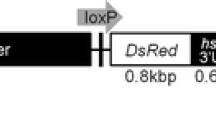Abstract
Recombinant CHO cell lines have integrated the expression vectors in various parts of the genome leading to different levels of gene amplification, productivity and stability of protein expression. Identification of insertion sites where gene amplification is possible and the transcription rate is high may lead to systems of site-directed integration and will significantly reduce the process for the generation of stably and highly expressing recombinant cell lines. We have investigated a broad range of recombinant cell lines by FISH analysis and Giemsa–Trypsin banding and analysed their integration loci with regard to the extent of methotrexate pressure, transfection methods, promoters and protein productivities. To summarise, we found that the majority of our high producing recombinant CHO cell lines had integrated the expression construct on a larger chromosome of the genome. Furthermore, except from two cell lines, the exogene was integrated at a single site. The dhfr selection marker was co-localised to the target gene.





Similar content being viewed by others
Abbreviations
- DIG:
-
digoxigenin
- GCN:
-
gene copy number
- HGP:
-
highly glycosylated protein
- MCB:
-
master cell bank
References
Barnes LM, Bentley CM, Dickson AJ (2002) Stability of protein production from recombinant mammalian cells. Biotech Bioeng 81:631–639
Barnett RS, Limoli KL, Huynh TB, Ople EA, Reff ME (1995) Antibody production in Chinese Hamster ovary cells using an impaired selectable marker. In: Wang HY, Imanaka T (eds) Antibody expression and engineering. American Chemical Society, Washington, DC
Brown PC, Beverley SM, Schimke RT (1981) Relationship of amplified dihydrofolate reductase genes to double minute chromosomes in unstably resistant mouse fibroblast cell lines. Mol Cell Biol 1(12):1077–1083
Chen C, Chasin LA (1998) Cointegration of DNA molecules introduced into mammalian cells by electroporation. Somatic Cell Mol Genetics 24(4):249–256
Davies J, Reff M (2001) Chromosome localization and gen-copy-number quantification of three random integrations in Chinese-hamster ovary cells and their amplified cell lines using fluorescence in situ hybridisation. Biotechnol Appl Biochem 33:99–105
Derouazi M, Martinet D, Besuchet Schmutz N, Flaction R, Wicht M, Bertschinger M, Hacker DL, Beckmann JS, Wurm FM (2006) Genetic characterization of CHO production host DG44 and derivative recombinant cell lines. Biochem Biophys Res Commun 340(4):1069–1077. Epub 2005 Dec 27
Hoess RH, Ziese M, Sternberg N (1982) P1 site-specific recombination: nucleotide sequence of the recombining sites. Proc Natl Acad Sci USA 79(11):3398–3402
Kao FT, Puck TT (1968) Genetics of somatic mammalian cells, VII. Induction and isolation of nutritional mutants in Chinese hamster cells. Proc Natl Acad Sci USA 60(4):1275–1281
Kaufman RJ, Brown PC, Schimke RT (1979) Amplified dihydrofolate reductase genes in unstably methothrexate-resistant cells are associated with double minute chromosomes. Proc Natl Acad Sci USA 76:5669–5673
Kaufman RJ, Sharp PA, Latt SA (1983) Evolution of chromosomal regions containing transfected and amplified dihydrofolate reductase sequences. Mol Cell Biol 3(4):699–711
Kaufman RJ, Wasley LC, Spiliotes AJ, Gossels SD, Latt SA, Larsen GR, Kay RM (1985) Coamplification and coexpression of human tissue-type plasminogen activator and murine dihydrofolate reductase sequences in Chinese hamster ovary cells. Mol Cell Biol 5(7):1750–1759
Kim SJ, Lee GM (1999) Cytogenetic analysis of chimeric antibody-producing CHO cells in the course of dihydrofolate reductase-mediated gene amplification and their stability in the absence of selective pressure. Biotech Bioeng 64(6):741–749
Kuo MT, Vyas RC, Jiang LX, Hittelman WN (1994) Chromosome breakage at a major fragile site associated with P-glycoprotein gene amplification in multidrug-resistant CHO cells. Mol Cell Biol 14(8):5202–5211
Nunberg JH, Kaufman RJ, Schimke RT, Urlaub G, Chasin LA (1978) Amplified dihydrofolate reductase genes are localized to a homogeneously staining region of a single chromosome in a methotrexate-resistant Chinese hamster ovary cell line. Proc Natl Acad Sci USA 75(11):5553–5556
O’Gorman S, Fox DT, Wahl GM (1991) Recombinase-mediated gene activation and site-specific integration in mammalian cells. Science 251(4999):1351–1355
Palin AH, Critcher R, Fitzgerald DJ, Anderson JN, Farr CJ (1998) Direct cloning and analysis of DNA sequences from a region of the Chinese hamster genome associated with aphidicolin-sensitive fragility. J Cell Sci 111:1623–1634
Pallavicini MG, De Teresa PS, Rosette C, Gray JW, Wurm FM (1990) Effects of methotrexate on transfected DNA stability in mammalian cells. Mol Cell Biol 10(1):401–404
Ray M, Mohandas T (1976) Proposed banding nomenclature for the Chinese hamster chromosomes (Cricetulus griseus). Cytogenet Cell Genet 16(1–5):83–91
Strutzenberger K, Borth N, Kunert R, Steinfellner W, Katinger H (1999) Changes during subclone development and ageing of human antibody-producing recombinant CHO cells. J Biotechnol 69:215–226
Urlaub G, Chasin LA (1980) Isolation of Chinese hamster cell mutants deficient in dihydrofolate reductase activity. Proc Natl Acad Sci USA 77(7):4216–4220
Varshavsky A (1981) Phorbol ester dramatically increases incidence of methotrexate-resistant mouse cells: possible mechanisms and relevance to tumor promotion. Cell 25(2):561–572
Wahl GM, Vitto L, Padgett RA, Stark GR (1982) Single-copy and amplified CAD genes in syrian hamster chromosomes localized by a highly sensitive method for in situ hybridization. Mol Cell Biol 2(3):308–319
Wilson C, Bellen HJ, Gehring WJ (1990) Position effects on eukaryotic gene expression. Annu Rev Cell Biol 6:679–714
Yoshikawa T, Nakanishi F, Itami, S, Kameoka D, Omasa T, Katakura Y, Kishimoto M, Suga K-I (2000a) Evaluation of stable and highly productive gene amplified CHO cell line based on the location of amplified genes. Cytotechnology 33:37–46
Yoshikawa T, Nakanishi F, Ogura Y, Oi D, Omasa T, Katakura Y, Kishimoto M, Suga K-I (2000b) Amplified gene location in chromosomal DNA affected recombinant protein production and stability of amplified genes. Biotechn Prog 16:710–715
Acknowledgements
This research was kindly funded by ACBT (Austrian Center of Biopharmaceutical Technology), a competence centre supported by the Federal Ministry of Economy and Labour and the federal states of Vienna and Tyrol. The authors are grateful to Annalisa Lasagna for analysis of product concentrations and to Friedemann Hesse for carefully reviewing the manuscript.
Author information
Authors and Affiliations
Corresponding author
Rights and permissions
About this article
Cite this article
Lattenmayer, C., Loeschel, M., Steinfellner, W. et al. Identification of transgene integration loci of different highly expressing recombinant CHO cell lines by FISH. Cytotechnology 51, 171–182 (2006). https://doi.org/10.1007/s10616-006-9029-0
Received:
Accepted:
Published:
Issue Date:
DOI: https://doi.org/10.1007/s10616-006-9029-0




